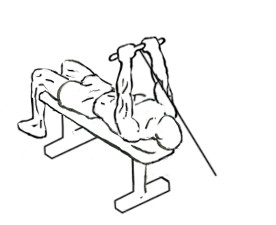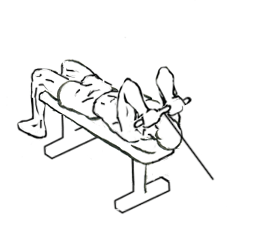Last Updated on September 27, 2014
The lying tricep extension with cable is a highly effective exercise that isolates the triceps, the muscles on the back of the upper arms. Using a cable machine provides consistent tension throughout the movement, making it ideal for building strength, definition, and stability in the triceps. This exercise is excellent for anyone looking to add variety to their arm workout, improve upper body aesthetics, and develop a well-rounded arm routine.
In this guide, we’ll cover everything you need to know about performing the lying tricep extension with cable, including step-by-step instructions, benefits, tips for optimal form, common mistakes, and variations to keep your tricep workouts engaging and challenging.
Why the Lying Tricep Extension with Cable is Essential for Tricep Development
- Constant Tension for Greater Muscle Activation
Unlike free weights, the cable provides steady resistance throughout the entire range of motion. This consistent tension enhances muscle activation and ensures that the triceps are working hard at every point of the movement. - Effective Isolation of the Triceps
This exercise minimizes shoulder and other muscle engagement, focusing solely on the triceps. The lying position allows you to concentrate on fully isolating the triceps, maximizing effectiveness. - Enhanced Stability and Control
Using the cable provides added stability and control, which is especially helpful for lifters who want to avoid joint strain. This controlled movement is perfect for isolating the triceps without putting stress on other parts of the upper body. - Great for Tricep Strength and Definition
Regularly incorporating the lying tricep extension with cable into your routine can build strength and enhance muscle definition, creating the toned, well-defined arms you’re aiming for. - Excellent Addition to Arm Workouts
This exercise is a valuable addition to any tricep routine, providing variety and targeting the triceps from a different angle compared to traditional extensions with dumbbells or barbells.
How to Perform the Lying Tricep Extension with Cable: Step-by-Step Guide
Follow these steps to master the lying tricep extension with cable and get the most out of this tricep-focused exercise:
1. Set Up the Cable Machine and Bench
Position a flat bench with one end close to the weight stack of a cable machine. Attach a short straight bar to the low pulley, adjusting the pulley to its lowest setting for optimal range of motion.
2. Lie Down and Position Your Grip
Lie face up on the bench with your head positioned near the cable stack. Grasp the bar with a narrow overhand grip (palms facing down), keeping your hands close together to engage the triceps.
3. Extend Your Arms Above Your Chest
Begin with your arms fully extended above your chest. This is your starting position. Be mindful to keep your wrists straight, avoiding any excessive bending.
4. Lower the Bar by Bending Your Elbows
Inhale as you slowly lower the bar toward your forehead, bending your elbows while keeping them stationary and close together. Your upper arms should remain still, with the movement focused on your forearms as they bend toward your body.
5. Extend Your Arms to the Starting Position
Exhale as you extend your arms, pressing the bar back to the starting position. Be sure to maintain control of the bar, avoiding any jerky movements as you return to the top.
6. Repeat for Desired Repetitions
Perform the exercise for your chosen number of repetitions, aiming for 3–4 sets for optimal tricep activation and development.
Tips for Perfecting the Lying Tricep Extension with Cable
- Maintain Control Throughout
Focus on a slow, controlled movement throughout each rep. Quick, uncontrolled motions can shift tension away from the triceps and compromise form. - Keep Elbows Stationary
Avoid allowing your elbows to drift outward or inward. Keeping them aligned helps isolate the triceps, ensuring you get the most out of the movement. - Engage Core for Stability
Although you’re lying down, engage your core muscles to provide additional stability and prevent any excessive arching in your back. - Use a Light Weight Initially
Begin with a lighter weight to practice your form and control. Increasing weight too quickly can lead to poor technique and reduce the effectiveness of the exercise. - Focus on the Stretch at the Bottom
As you lower the bar, focus on stretching the triceps without locking your elbows. This full range of motion enhances muscle engagement and effectiveness.
Common Mistakes to Avoid
- Using Excessive Weight
Starting too heavy can compromise your form, cause your elbows to flare, and reduce tricep isolation. Begin with a manageable weight and only increase as you become comfortable with the movement. - Letting Elbows Drift
When the elbows drift outward, it shifts the focus away from the triceps. Ensure your elbows stay tucked in and aligned throughout the exercise. - Bending or Locking Wrists
Bending or locking your wrists can strain the joint. Keep your wrists straight and neutral for maximum comfort and effectiveness. - Arching Your Back
Maintain contact between your back and the bench by engaging your core. Avoid excessive arching, which reduces stability and can lead to poor form. - Neglecting the Lowering Phase
The eccentric phase (lowering the weight) is crucial for muscle growth. Lower the bar slowly to keep the triceps engaged and avoid losing tension.
Variations of the Lying Tricep Extension with Cable
Try these variations to add variety to your routine and target the triceps from different angles:
- Lying Tricep Extension with Rope Attachment
Swap the straight bar for a rope attachment to provide a wider range of motion and further isolate the triceps. The rope allows for a deeper contraction at the top of each rep. - Single-Arm Lying Cable Tricep Extension
Perform the exercise one arm at a time to address muscle imbalances and enhance focus on each tricep independently. This variation also increases stability requirements. - Incline Bench Lying Cable Tricep Extension
Set the bench at a slight incline to change the angle of the movement. This adjustment shifts the focus to different parts of the tricep muscle and provides a new challenge. - Overhead Cable Tricep Extension (Standing)
Stand facing away from the cable machine and perform an overhead tricep extension. This movement provides a great stretch in the triceps and works the long head of the muscle. - Slow Tempo Extension
Slow down the tempo, especially during the lowering (eccentric) phase, to increase time under tension. This variation challenges the triceps and improves muscle control.
Incorporating the Lying Tricep Extension with Cable into Your Workout
Here’s how to use the lying tricep extension with cable in your tricep or upper body routine to achieve the best results:
- Strength Training Focus
For strength gains, aim for 3–5 sets of 4–6 reps with a challenging weight. This low-rep range encourages strength development while focusing on proper form. - Muscle Growth and Definition
For muscle growth, perform 3–4 sets of 8–12 reps with moderate weight. This rep range is ideal for building mass and enhancing definition in the triceps. - Endurance and Tone
To build endurance and achieve a toned look, perform 2–3 sets of 15–20 reps with lighter weight. High reps build muscular endurance and improve definition without adding bulk. - Use as a Finisher
Add this exercise as a finishing move in your tricep workout to fully exhaust the muscle. Perform 2–3 sets of 12–15 reps to achieve a final burnout. - Pair with Compound Exercises
Combine the lying tricep extension with cable with compound movements like dips or close-grip bench presses for a balanced and effective tricep workout.
Safety Tips for Performing the Lying Tricep Extension with Cable
- Start Light
Begin with a manageable weight to focus on perfecting your form. Gradual weight increases reduce the risk of strain or injury. - Keep Wrists Neutral
Avoid bending or overextending your wrists during the curl. A neutral wrist position ensures comfort and prevents strain on the joint. - Engage Core Muscles
Keep your core engaged to maintain a stable position on the bench. Stability ensures better form and reduces the risk of lower back strain. - Monitor Elbow Position
Keep your elbows stationary and tucked close to your body to prevent shoulder involvement. Stability in the elbows maximizes tricep activation and minimizes joint stress. - Progress Gradually
Avoid increasing weight too quickly. A gradual approach to progression promotes steady strength gains and minimizes the risk of strain.
Frequently Asked Questions
Q1: Is the lying tricep extension with cable suitable for beginners?
A: Yes, beginners can perform this exercise by starting with light weights to focus on form. Working with a trainer initially can also help ensure proper technique.
Q2: How often should I do the lying tricep extension with cable?
A: Include this exercise in your tricep routine once or twice a week, allowing at least 48 hours between sessions for recovery.
Q3: Should I use the lying tricep extension with cable instead of free weights?
A: The lying tricep extension with cable offers continuous tension, which can be beneficial for muscle activation. However, free weights (like dumbbells) also provide effective resistance and can be alternated with cable exercises to target the triceps from different angles. Including both in your routine offers variety and comprehensive muscle development.
Q4: What grip should I use for the best results?
A: An overhand grip with hands close together is recommended for optimal tricep activation. This grip isolates the triceps effectively while minimizing shoulder and chest involvement.
Q5: Can this exercise help with elbow stability?
A: Yes, the lying tricep extension with cable can improve elbow stability by strengthening the triceps and surrounding muscles. Just make sure to keep your elbows stationary and avoid heavy weights if you’re working on stability, to reduce joint strain.
Advanced Tips for Maximizing Results from the Lying Tricep Extension with Cable
- Incorporate Pause Reps
Pause at the bottom of each extension for 1–2 seconds to intensify the stretch and contraction in the triceps. This technique increases muscle engagement, enhancing overall strength and definition. - Use a Drop Set Technique
For an added challenge, perform a drop set: after reaching muscle failure, reduce the weight by 20–30% and continue to complete additional reps until failure. This method fully exhausts the triceps and promotes muscle growth. - Change Rep Tempo for Extra Tension
Slow down both the lifting and lowering phases to increase time under tension, which is excellent for muscle growth and control. Try a 3-second lowering phase and a 1-second contraction phase. - Try Supersets for Greater Muscle Activation
Superset the lying tricep extension with another tricep exercise, such as tricep pushdowns or close-grip pushups. This combination challenges the triceps further and maximizes engagement. - Visualize Each Rep for Improved Focus
Concentrate on the triceps as you perform each rep. This mind-muscle connection can improve activation and, over time, lead to better strength and muscle development.
Wrapping Up: Sculpt and Strengthen Your Triceps with the Lying Tricep Extension with Cable
The lying tricep extension with cable is a highly effective exercise that isolates the triceps, providing consistent tension that helps sculpt and define the upper arms. Whether you’re new to tricep training or looking to add variety to your routine, this exercise is versatile, accessible, and provides a great way to target the triceps from a unique angle.
Including the lying tricep extension with cable in your workout routine—alongside other compound and isolation movements—will enhance the appearance and strength of your upper arms. Focus on form, control, and progression, and be consistent with your training for optimal results. With the lying tricep extension with cable, you’re well on your way to building strong, toned triceps that support overall upper body strength and add to a well-defined arm aesthetic.








